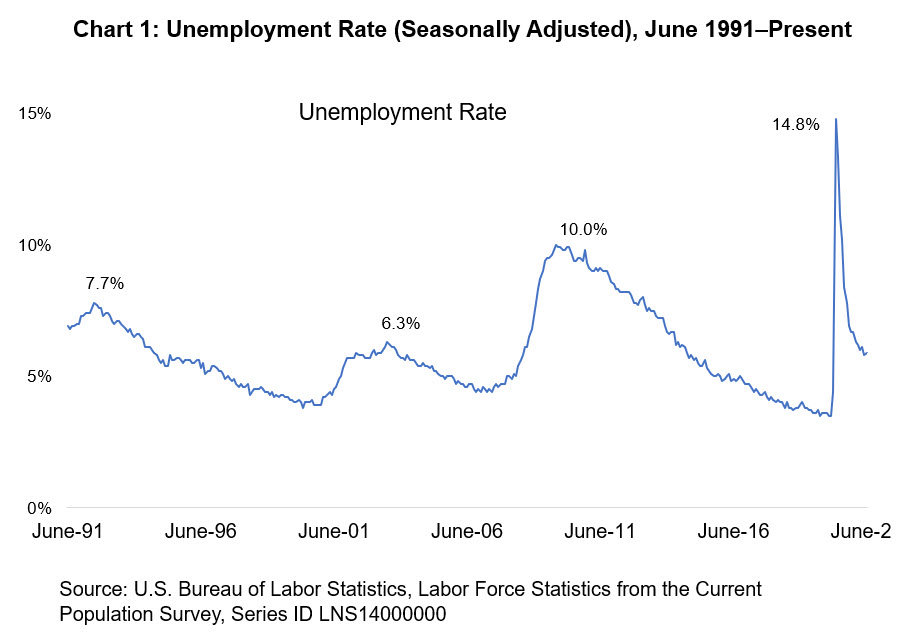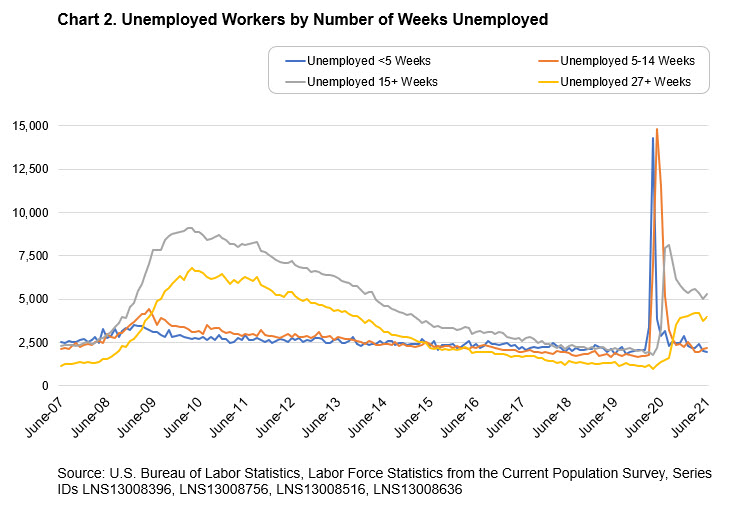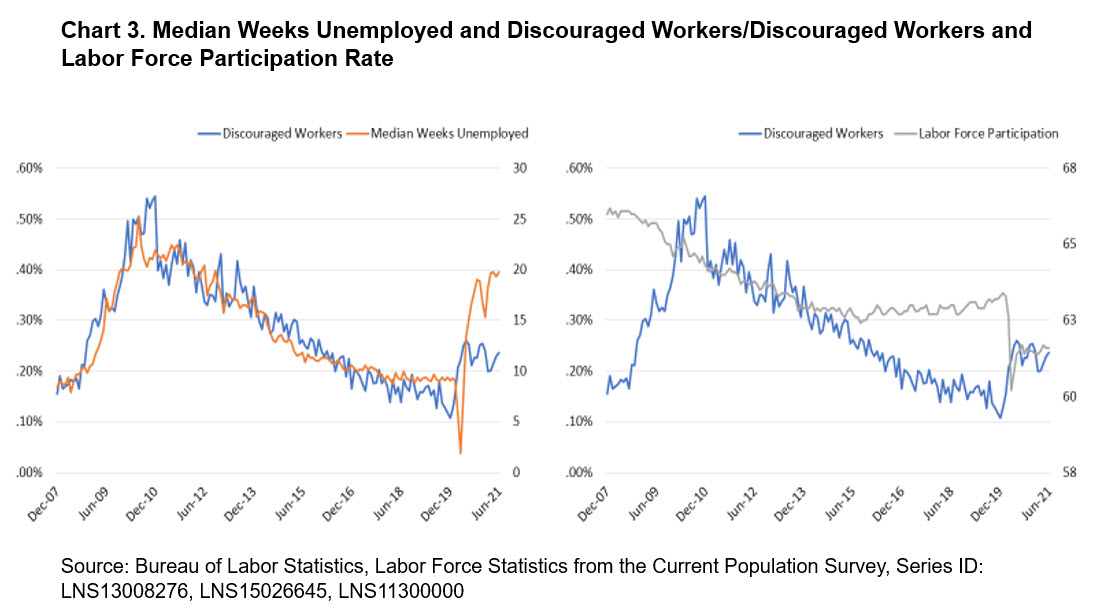
The Importance of Addressing Long-Term Unemployment for Economic Recovery
Katherine Townsend Kiernan and Sarah Miller
August 5, 2021
2021-06
https://doi.org/10.29338/wc2021-06
Download the full text of this paper (352 KB)
In April 2020, the U.S. unemployment rate skyrocketed to 14.8 percent from a low of 3.5 percent because of stay-at-home orders and fears over the COVID-19 pandemic. Following the initial lockdown in April and May 2020, the unemployment rate declined rapidly, reaching 5.9 percent in June 2021.1 Nonetheless, many workers, a large fraction of whom have been out of work for a long time, face challenges.

According to the U.S. Bureau of Labor Statistics (BLS), fewer workers had been laid off or fired in June 2021 than in the previous month, and 850,000 new jobs had been added.2 However, the number of workers considered to be long-term unemployed (LTU)— jobless for longer than 26 weeks—has hovered around 4 million since the beginning of 2021. This suggests there is still much work to be done to ensure that long-term unemployment continues to decrease as the country recovers from the global COVID-19 pandemic. Currently, the long-term unemployed account for around 40 percent of the total number of unemployed workers—a fraction similar to what we saw in the wake of the Great Recession and double the fraction in 2019, prior to the pandemic.
Many factors can drive long-term unemployment, including structural changes in the labor market. The BLS defines structural unemployment as the result of an economy reorganizing, usually because of technological changes or offshoring that render some jobs obsolete or demographic changes that create a mismatch of skills between generations.3,4Reorganization can occur when an economy shifts from agricultural to manufacturing, or from goods producing to services producing.
Conversely, cyclical unemployment is temporary, occurring when workers lose their jobs during a recession or downturns of the business cycle. These job losses are not structural and are generally short-term experiences for most workers. Unfortunately, some workers move from cyclical unemployment to structural unemployment.
The length of time for a worker to be considered LTU changed with the BLS's June 1994 June Employment Situation news release.5 The BLS changed the duration for LTU from 15 weeks or longer to 27 weeks or longer because after the 1990–91 recession, workers tended to stay unemployed for a longer time than after previous economic downturns.6 In 2011, following the Great Recession, the Current Population Survey changed the upper limit on the reportable duration of unemployment from two to five years due to an "unprecedented rise in the number of persons with very long durations of unemployment during the recent labor market downturn."7

The structural changes that can occur after recessionary shocks like the one recently experienced significantly reduce the ability of long-term-unemployed workers to reenter the labor market. Social distancing measures that companies took to try to reduce the risk of spreading COVID-19 exacerbated this tendency, forcing them to look to automated processes and thus speeding up the adoption of new technologies.8 Many of the jobs that were replaced with automated processes are likely to stay lost, even as other jobs return to the market.
Effects of Long-Term Unemployment
The longer workers are unemployed, the less likely finding a new job can become. A 2013 paper found that the duration of a job seeker's unemployment has a significantly negative effect on receiving an interview for a job application.9 Other research finds that discrimination based on unemployment status is unjustifiable based on the job performance of previously LTU workers and their peers.10
Individuals can also face wage depression after periods of long-term unemployment, according to a 2017 article published in the American Economic Review. The authors found that workers with extended periods of unemployment (greater than one year) can face earnings losses of up to 40 percent 10 years after job separation and lifetime losses of 10 percent.11 In low-wage sectors, wage loss had a strong correlation to extended unemployment. Furthermore, the authors found that the high earnings loss was largely due to workers leaving the labor market entirely. Previous work focusing on mass layoffs also found large wage differentials six years after job separation.12
Unemployment can also cause a worker to completely detach from the labor market. Measuring labor force participation, the employment-to-population ratio, and the proportion of discouraged workers can indicate detachment. After the Great Recession ended in June 2009, discouraged workers, or those who have left the labor force because they have given up, increased from 0.15 percent of the working-age population (ages 16 and older) to 0.33 percent. Though GDP began recovering in June 2009, the unemployment rate continued to grow, peaking at 10 percent in October 2009. Workers who remained unemployed after that point faced longer spells of unemployment, with the median number of weeks out of work peaking at 25.2 in June 2010. Given the slow recovery, it should be no surprise that the number of discouraged workers did not start to drop until January 2011. Labor force participation and the employment-to-population ratio never fully recovered after the Great Recession.13
Just before the COVID-19 pandemic and corresponding recession, the percentage of the population considered to be discouraged workers fell to 0.11 percent, the lowest rate since 1994. Discouraged workers doubled by April 2020 and reached 0.26 percent by June 2020. Since then, the measure has remained relatively flat, with little movement in either direction. Median weeks unemployed began to fall in third-quarter 2020 but has since reversed, increasing to 19.8 weeks in June 2021, well above the historical average (1992–2021) of 10.9 weeks. If trends from the Great Recession's recovery period prevail during the COVID-19 recovery, median weeks unemployed would be a leading indicator for discouraged workers, and in turn discouraged workers would be a leading indicator for the labor force participation rate (inversely correlated). If these relationships hold true, the percentage of workers who drop out of the labor force would continue to grow until long-term unemployment returns to near pre-pandemic rates.14

A strong labor force participation rate is important for a strong economy. According to economists from the Federal Reserve Bank of Philadelphia, consequences of reduced participation include slower economic growth, a higher dependency ratio (because there are fewer workers supporting nonworkers), and a smaller tax base (which could lead to higher taxes).15 Though many factors could explain why overall participation has been falling, including an aging population choosing to retire and wage inequality, a reduction in the length of time workers are unemployed could encourage them to rejoin the labor market and mitigate the effects of the labor force participation rate fall as a result of a recession.
Disparities in Long-Term Unemployment and Labor Force Participation
While women have experienced fewer weeks unemployed than men have as a result of the pandemic, this is not likely to be because they have been hired into jobs more often than men. Dropping out of the labor force is one of the economic effects of long-term unemployment and women have dropped out of the labor force at higher rates than men. Labor force participation rates have ticked up for men but remained consistent for women, though both are still below prepandemic levels. For women who remain in the labor force and unemployed, a higher proportion of women of color are long-term unemployed. More Black women (41.3 percent) and Asian women (42.4 percent) workers are unemployed for more than 27 weeks compared to White women workers (37.6 percent).16
Older unemployed workers (workers over the age of 55) are also out of work longer than younger workers. In June 2021, 39.6 percent of workers ages 16 and older spent more than 27 weeks unemployed. Of unemployed workers over 55, 55.9 percent were long-term unemployed. In addition, older workers, both men and women, dropped out of the labor force faster than any other group, choosing retirement over long-term unemployment.17
Age bias plays a role for the older workers who are eager to find a new job. Research published by AARP reveals that age discrimination has increased since 2018, increasing from 61 percent in 2018 to 78 percent in 2021.18,19 In a Harvard Business Review article, Ofer Sharone describes the results of a series of interviews he conducted with workers and recruiters from 2013 to 2015. Many respondents agreed that older workers in the job market experience age discrimination.20 One recruiter attributed this to the perceived learning ability of older workers, compared to younger ones. Another recruiter noted that having more than the maximum suggested years of experience was a "problem," likely because of salary requests or the length of time the company expects the worker to stay. This is sometimes referred to as the "success bias."
Supporting the Long-Term Unemployed
Supporting workers experiencing long-term unemployment is important to minimize structural unemployment and increase labor force participation. Many job seekers who may want to work leave the labor market because their skills no longer match the available jobs. As job creation continues during the recovery and as workers reenter the job market, upskilling, reskilling, and ensuring skills transferability from prior jobs or industries will be critical to get the LTU back into the labor force. Programs that help assess reskilling and rehiring can help reduce friction in the labor market for workers who need to learn new skills. Assessments, skills training, and job-finding supports for workers who are unemployed are promising practices that have shown results—and could be expanded to help workers at risk of long-term unemployment.21
Policies to support mid-career workers who have found themselves out of work for six months or longer could address two distinct needs of workers: (1) access to quality jobs that pay family-sustaining wages, and (2) support for and direction to skill development, education, or training to make them competitive for these jobs. Since LTU has historically lowered lifetime earnings, creating policies that will support skill development is crucial to labor market success. Training and other support for LTU workers should not only help them acquire skills for good jobs but also should prioritize placing them in new jobs that pay family-sustaining wages and enable them to create enough wealth for later retirement.
Even while mid-career workers are experiencing LTU, companies may be experiencing a vacuum in expertise and industry knowledge that these workers could fill. In other words, the gap in the labor force caused by long-term unemployment could affect the worker pipeline for managerial positions needed to sustain business operations and growth.
Older workers, who face longer spells of unemployment than other age groups, are likely to receive lower wages, experience health risks, or retire. Older workers who are eager to be reemployed could accept jobs that pose higher health risks or offer lower wages than jobs they've held in the past. Like mid-career workers, older workers provide knowledge and leadership within their companies and industries. Failing to reemploy older workers at the level they had previously held, or to reemploy them at all, will leave a vacuum in industry knowledge that is hard to replicate through other types of training for less seasoned workers.
Although LTU workers may struggle to find job opportunities because of employer bias against unemployment, a handbook on recruiting the LTU by Deloitte and the Rockefeller Foundation22 cites a study finding that companies that focused on skills rather than only on experience saw significant reductions in the time and cost to hire and train new workers and a decrease in employee turnover, up to 75 percent. Employers should complement the benefits they gain from this focus on skills with investments in employee benefits such as on-the-job training and other upskilling as necessary to meet their specific business needs.
To address long-term unemployment during the Great Recession, many countries, including the United States, allocated funding for policies to support these unemployed workers. Analysis by Jochen Kluve on the effectiveness of labor market program types in the European Union found these programs had a generally positive effect, indicating that policy intervention could be a successful avenue for addressing long-term unemployment.23 Of the different types of policy and program interventions, training programs had the greatest impact on post-program earnings and unemployment status. Additionally, job assistance programs were a successful investment to help workers find employment in the short term.24
As the economy recovers from the pandemic's effects, thoughtful policy surrounding training and reemployment can boost growth and help the economy move back to prepandemic levels on many indicators. Funding training programs is a strategic investment for reducing long-term unemployment. However, rapid reemployment is also a priority, so funding should focus on policies that combine the two programs, such as apprenticeships or other earn-and-learn models, specifically for young workers. Older workers will benefit from job assistance programs, especially if they are targeted to help workers move into equal or higher-paying positions.
_______________________________________
1 U.S. Bureau of Labor Statistics. (June 2021). The Employment Situation. Retrieved from https://www.bls.gov/news.release/pdf/empsit.pdf.
2 Ibid.
3 Kevin S. Dubina. (November 2017). "Full employment: an assumption within BLS projections," Monthly Labor Review, U.S. Bureau of Labor Statistics. https://doi.org/10.21916/mlr.2017.30
4 Frank Reid and Douglas A. Smith. (1981). "The Impact of Demographic Changes on Unemployment." Canadian Public Policy / Analyse De Politiques, 7(2), 348-351. doi:10.2307/3549234.
5 U.S. Bureau of Labor Statistics. (May 1994). The Employment Situation. Retrieved from https://www.bls.gov/news.release/history/empsit_060394.txt.
6 Andie Corban and Kai Ryssdal. (2021, May 20). "Why long-term unemployment starts at 27 weeks." NPR: Marketplace. Retrieved from https://www.marketplace.org/2021/05/20/why-long-term-unemployment-starts-27-weeks/.
7 U.S. Bureau of Labor Statistics. (2011, July 8). "Changes to data collected on unemployment duration." Retrieved from https://www.bls.gov/cps/duration.htm.
8 Tamar Jacoby. (2020, November 13). "Can Community Colleges Step Up as Engines of Economic Recovery?" Federal Reserve Bank of Atlanta. Retrieved from https://www.atlantafed.org/cweo/workforce-currents/2020/11/13/can-community-colleges-step-up-as-engines-of-economic-recovery.aspx.
9 Kory Kroft, Lange, F., Notowidigdo, M. J. (2013, June 7). "Duration Dependence and Labor Market Conditions: Evidence from a Field Experiment*" Quarterly Journal of Economics, 128(3), 1123–67. https://doi.org/10.1093/qje/qjt015
10 Peter Norlander, Ho, G., Shih, M., Walters, D., Pittinsky, T. (2019, November 13). "The Role of Psychological Stigmatization in Unemployment Discrimination." Basic and Applied Social Psychology, 42, 1–21. https://doi.org/10.1080/01973533.2019.1689363
11 Fatih Guvenen, Karahan, F., Ozkan, S., Song, J. (May 2017). "Heterogeneous Scarring Effects of Full-Year Nonemployment." American Economic Review, 107 (5): 369–73.
12 Louis S. Jacobson, LaLonde, R.J., Sullivan, D.G. (September 1993). "Earnings Losses of Displaced Workers." American Economic Review, 83 (4): 685–709.
13 Analysis provided by Katherine Townsend Kiernan, Research Analyst for the Center for Workforce and Economic Opportunity at the Federal Reserve Bank of Atlanta. Data can be found at the Bureau of Labor Statistics Current Population Survey. Series IDs: Labor Force Participation, LNS11300000; Discouraged Workers, LNS15026645; Median Weeks on Unemployment, LNS13008276; Labor Force Participants, LNS11000000; Not in the Labor Force, LNS15000000.
14 Ibid.
15 Michael Dotsey, Fujita, S., Rudanko, L. (2017). "Where Is Everybody? The Shrinking Labor Force Participation Rate: More Americans are neither working nor looking for work. What is going on?" Economic Insights. Federal Reserve Bank of Philadelphia. Retrieved from https://www.philadelphiafed.org/-/media/frbp/assets/economy/articles/economic-insights/2017/q4/eiq417.pdf.
16 U.S. Bureau of Labor Statistics. (2021, July 2). Labor Force Statistics from the Current Population Survey; Household Data; Not Seasonally Adjusted; Table A-36. Unemployed persons by age, sex, race, Hispanic or Latino ethnicity, marital status, and duration of unemployment. Labor Force Statistics from the Current Population Survey; Household Data; Table A-8b. Persons in the labor force and labor force participation rates by age and sex, seasonally adjusted.
17 U.S. Bureau of Labor Statistics. (2021, July 2). Labor Force Statistics from the Current Population Survey; Household Data; Not Seasonally Adjusted; Table A-36. Unemployed persons by age, sex, race, Hispanic or Latino ethnicity, marital status, and duration of unemployment.
18 Rebecca Perron. (May 2021). Understanding Older Workers during the Coronavirus Pandemic. Washington, DC: AARP Research. https://doi.org/10.26419/res.00445.001
19 Rebecca Perron. (July 2018). The Value of Experience: AARP Multicultural Work and Jobs Study. Washington, DC: AARP Research. https://doi.org/10.26419/res.00177.000
20 Ofer Sharone. (2021, March 18). "A Crisis of Long-Term Unemployment Is Looming in the U.S." Harvard Business Review. Retrieved from https://hbr.org/2021/03/a-crisis-of-long-term-unemployment-is-looming-in-the-u-s.
21 Stuart Andreason. (2020, April 2). Reemploying the Unemployed. Federal Reserve Bank of Atlanta. Retrieved from https://www.atlantafed.org/cweo/workforce-currents/2020/04/02/reemploying-the-unemployed.aspx.
22 Deloitte Consulting LLP and The Rockefeller Foundation. (October 2014). A Guide to Recruiting and Hiring the Long-Term Unemployed: A Handbook for Employers.
23 Jochen Kluve. (December 2010). "The effectiveness of European active labor market programs." Labour Economics, 17(6), 904–18. https://doi.org/10.1016/j.labeco.2010.02.004. Accessed at https://www.sciencedirect.com/science/article/pii/S092753711000014X.
24 David Card, Kluve, J., Weber, A. (2010, October 19). "Active Labour Market Policy Evaluations: A Meta‐Analysis." The Economic Journal, 120(548). https://doi.org/10.1111/j.1468-0297.2010.02387.x. Accessed at https://davidcard.berkeley.edu/papers/card-kluve-weber-EJ.pdf.


